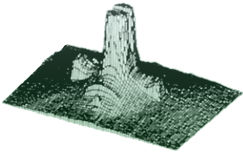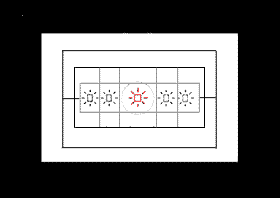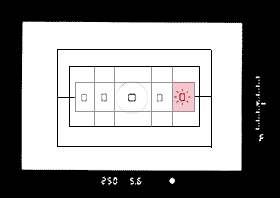b) Central partial metering Partial metering is based on the output of the A0, A1, A2 and B5 sections of the evaluative metering sensor, and covers approximately 9% of the viewfinder's viewing area. The sensitivity distribution is shown. There are two methods to choose from when using the Spot Meter, the 16-Zone Meter Sensor that doubles to provide fine spot metering which links directly to one of the five focusing area via activation of a Custom Function. The alternative spot meter is detailed below as it is handled by the Canon BASIS chip. The 3.5-percent spot metering can be used when Custom Function CF-13 is set to 1. in such case, this spot metering links to the active focusing point (read more this topic at below).
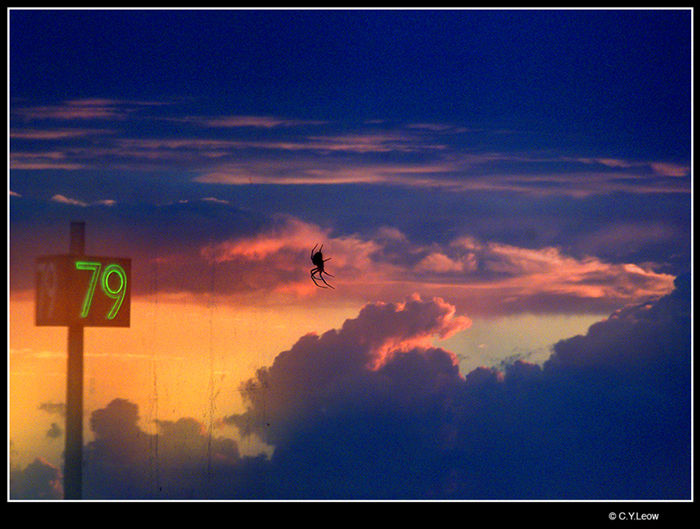 |
|
c) Fine spot metering Fine-spot metering is carried out based on the output of the AE sensor fabricated on the AF system's Multi-Sensor BASIS chip, and covers approximately 2.3% of the viewfinder's viewing area. The sensitivity distribution of the fine spot metering sensor is also shown at the illustration. As can be seen in the sensitivity diagram, there is a non-responsive band running horizontally through the center of the fine spot metering area. This is similar to the sensitivity distribution of the EOS-1's fine spot metering function, and is due to the overlap of the AF Multi-Sensor BASIS chip's C-H-BASIS light receptor. This non-responsive band presents no problems in actual use.
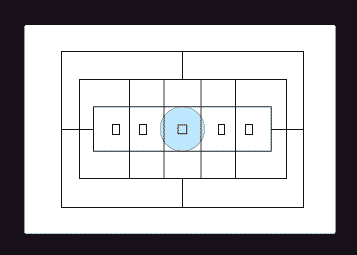 |
|
Metering areas used for comparison at each focusing point :-
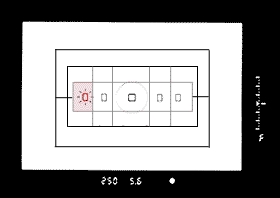 |
|
|
 |
|
d) Center-weighted average metering (no evaluation; selectable with CF-No. 8-1). Like the Partial and Fine spot metering, it uses the same 16-zone metering sensor. Calculation of the metering value in this mode is based on the output of all sections of the 16-zone AE sensor. However, no automatic exposure compensation is added by the evaluative metering algorithm, and the position of the center-weighted: point is always in the center of the frame regardless of the selected focusing point. Illustrations show the sensitivity distribution of the EOS-1N's center-weighted average metering function, and next illustration shows the sensitivity distribution of the EOS-1's Centre-Weighted average metering function.
 |
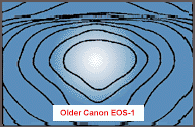 |
 |
|
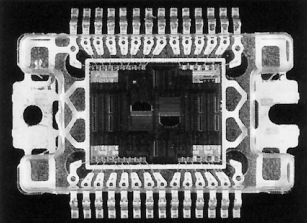 |
|
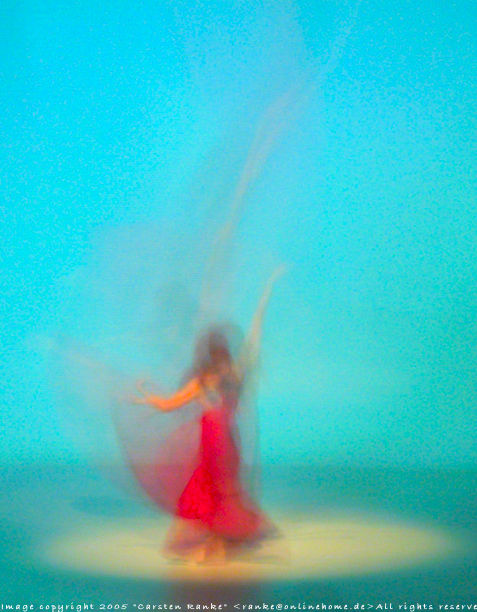 |
e) Spot metering By setting CF-No. 13-1, the EOS-1N can be configured to carry out spot metering linked to the focusing point selected by the user. The A0, A1, A2, A3 and A4 sections of the evaluative metering sensor are spot metering sensors, with each sensor covering approximately 3.5% of the viewfinder's viewing area. Central spot metering (using the A0 sensor) is automatically set in automatic focusing point selection mode. In manual focusing mode, spot metering is linked to the manually selected focusing point. |
f) TTL flash metering sensor: The TTL Flash meter SPC (Silicon Photo Cell) sensor is independent console and forms the last among the three sensors deployed in the Canon EOS-1n. Metering of light reflected off the film plane TTL flash metering is carried out by a three-zone TTL metering sensor (same as the EOS 5 and Canon EOS 10) located in the bottom of the mirror box.
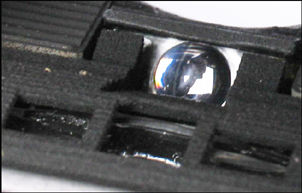 |
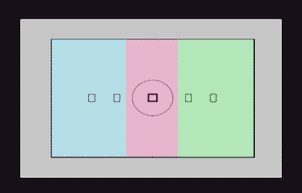 |
<<<--- The three primary segments for OTF TTL auto flash metering. It is a simplified form evolved from the more complex 16-zone evaluative metering for ambient light metering. Works with dedicated Canon Speedlite(s) only. Far left, a quick snap of the internal TTL Flash metering sensors and AF module. |
NOTE:- a) A-TTL (advance-TTL) Automatic Flash Metering/exposure
control
(![]() ) b)
TTL Automatic
Flash Metering/exposure control
c) Flash exposure
compensation
and setup procedure:- Flash exposure control in the EOS-1N can also be
categorized as part of its Exposure control system. All these have been grouped under
the FLASH
PHOTOGRAPHY with EOS-1N
section.
) b)
TTL Automatic
Flash Metering/exposure control
c) Flash exposure
compensation
and setup procedure:- Flash exposure control in the EOS-1N can also be
categorized as part of its Exposure control system. All these have been grouped under
the FLASH
PHOTOGRAPHY with EOS-1N
section.
previous | Next | Various Exposure Control Methods
Metering: Part One | Part Two
| Questions, Issues
& Answers
| Canon
EOS-1 Series Message
Board
|
Canon
EF lens Board
| in
a shared environment
|
Free Trade Zone |
shared
environment
| Back | Index Page The Canon EOS-1N
Series Professional SLR camera
|
Back | Main Index Page The Canon EOS-1
Series Professional SLR camera
Background and Various Issues
| The Basic
Features &
various Setup
Manual &
Auto Focusing |
Metering Systems | Exposure Control | Viewfinder
Optical
System Flash Photography (with Speedlite 540EZ extension & Selective info on Canon TTL Flash Models:-160E | 200E
| 300EZ | 300TL
| 420EZ | 430 EZ | 480EG | Macrolite
| Other non-TTL Canon flash model
Reliability Issues:- Body Chassis | Shutter Unit | Electronic Circuitry | Film Transport & film handling Secondary Functions:- Custom Function Part One | Part Two | System Accessories:- Film Back Options - instruction for Command Back E1 | Macro/Close Up Part one | Part two and Part III Flash for Macro-Photography | Power Sources -BP-E1 | PDB-E1 | Focusing Screens | Remote Control with Wireless Remote Set LC-3 | System compatibility
Variants of Canon EOS-1N:- Canon EOS-1N RS | Canon/Kodak Digital DCS-1, 3 -5 & 520/560 Series | Full Technical Specification | Main
Reference Map / Nomenclature
| Resource Centre:- Comparative Charts between EOS-1 &
EOS-1N / or with
its active Competition(s) (Nikon); Quick Operational Reference Card (278k Gif File);
Listings of 7-segment
digital numbers/letters
appeared on LCD display panel/viewfinders (HTML page); External Link:-Instruction Manual (3.3MB
PDF file applicable for both Canon
EOS-1N (RS). | Using EOS system for your photography | Bots & Nuts of EOS System - by Philip Chong |
The Eyes of EOS -
EF Lenses
A little OFF-TOPIC SOME Personal Thought
HOME - Photography in Malaysia |
Volunteered Maintainer(s) for the Canon EOS-1N Series Message Board: Philip Chong, Editor, Digital Camera Magazine; Vincent Thian, Photo Editor, Malaysian Bureau, Associated Press "AP", CYleow, Ex-photo Editor of local daily, The Star; Gary Rowan Higgins, Australia and other nice folks on the web.
Special Credit:- :Mr. Richard Yeow & Mr. Simon Wong from camera division of ![]() Marketing Malaysia, for their continual effort in
supporting development of this EOS/EF website. Others: All the nice people on earth who have contributed
their photos and pictures of personal works or product shots for the creation of
this site. Certain content and images appeared in this site were either scanned
from official marketing leaflets, brochures published by Nikon and/or contribution
from surfers who claimed originality of their own work for public publishing in this
website, where majority of the extracted information are used basing on educational
merits. The creator of this site will not be responsible for any discrepancies that
may arise from any possible dispute except rectifying them after verification from
respective source. Neither Nikon or its associates has granted any permission(s)
in using their public information nor has any interest in the creation of this site.
"Canon", "EOS",
"EF" "RT", "EOS-1n RS", "Booster
", "Macrolite", "fluorite", "Image Stabilizer"
& other applicable technical/business terms are registered trade name(s) of Canon
Inc., Japan. Site made with an Apple G5 IMac.
Marketing Malaysia, for their continual effort in
supporting development of this EOS/EF website. Others: All the nice people on earth who have contributed
their photos and pictures of personal works or product shots for the creation of
this site. Certain content and images appeared in this site were either scanned
from official marketing leaflets, brochures published by Nikon and/or contribution
from surfers who claimed originality of their own work for public publishing in this
website, where majority of the extracted information are used basing on educational
merits. The creator of this site will not be responsible for any discrepancies that
may arise from any possible dispute except rectifying them after verification from
respective source. Neither Nikon or its associates has granted any permission(s)
in using their public information nor has any interest in the creation of this site.
"Canon", "EOS",
"EF" "RT", "EOS-1n RS", "Booster
", "Macrolite", "fluorite", "Image Stabilizer"
& other applicable technical/business terms are registered trade name(s) of Canon
Inc., Japan. Site made with an Apple G5 IMac.
